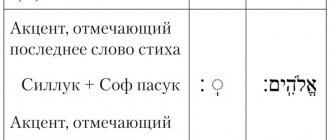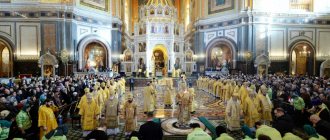Translation or gag?
In principle, the situation with translating the Bible is no different from translating any other text: you can try to convey the meaning of the original as accurately as possible, you can distort it, or you can deliberately obscure it.
Generations of translators tell the story about that interpreter, thanks to whom they managed to avoid an international scandal: when Khrushchev at the UN promised to “show the imperialists Kuzma’s mother,” he conveyed his words verbatim... and therefore completely colorless and incorrect: “we will show them Kuzma’s mother.”
English-speaking listeners, naturally, did not understand what was so special about the mother of Mr. Kuzma, unknown to them, but, in any case, they were not offended by the outright rudeness of the Soviet leader.
This is how the Bible is sometimes translated. Leo Tolstoy, for example, created his own version of the Gospel in order to bring the sacred book closer to the people. But at the same time, he did not limit himself to conveying the idea of the original in a simpler language - he changed the original itself, throwing out all the miracles from it, for example, the resurrection of Christ. Tolstoy's Christ is a moralist, like Lev Nikolaevich himself, and nothing more.
This is, of course, an extreme. Few translators make such a conscious change to the text... But something else is possible: an inaccurate understanding or even a conscious adjustment of the original to the translator’s ideas about it. And how do you know how much you can trust a new translation?
“Christianity is doomed to translation”
However, first you should understand why translation of the Holy Scriptures is needed at all. Some religions do just fine without this - they have their own sacred language. And to study Islam, you need to learn Arabic, and Judaism - Hebrew and Aramaic. And there is simply no other way. All translations of the sacred texts of Jews and Muslims into modern languages are nothing more than props for the weak: they do not and cannot have the same status as the originals. Why is everything different in Christianity?
The Old Testament was written mainly in Hebrew, and parts of it were written in Aramaic, a closely related language. It was Aramaic that Jesus Himself and His first disciples apparently spoke in everyday life. But the New Testament, oddly enough, is written from beginning to end in ancient Greek. The fact is that in the 1st century. n. e. In the eastern part of the Roman Empire, Greek was the language of international communication, like Russian in the former USSR.
So, not a single line has reached us in Jesus’ native language, and His followers from the very beginning chose not to create a special “sacred” language and wrote in such a way that it would be understandable to as many readers as possible. An amazingly bold step! For the sake of their readers, they refused to accurately convey the words of the Teacher Himself. But if the Son of God, having become incarnate, took this risk - to be misunderstood, then it is quite natural that His disciples also took it. And therefore, from the very beginning, Christianity turned out to be, in the words of S.S. Averintsev, “doomed to translation.”
So the preaching of Christianity to a particular nation usually began with the translation of selected biblical books into its language. The Slavs were no exception, for whom Saints Cyril and Methodius began translating the Bible. However, languages do not stand still, and therefore the need for new editions or completely new translations constantly arises. Until the 18th century, the Slavic translation was constantly refined and corrected: words that had fallen out of use and became incomprehensible were replaced with new ones, existing versions were compared with more authoritative Greek manuscripts.
The Slavic Bible, which is read today during church services, is sometimes called Elizabethan, because. it acquired its final form during the reign of Elizabeth Petrovna in the 18th century. Its text, of course, differs markedly from the Cyril and Methodius translations.
But in the 19th century, the need for Russian translation became increasingly noticeable: even the educated class no longer used the Slavic language, and Pushkin, for example, preferred to read the Bible... in French. After much debate and doubt, both the Church and the state authorities agreed to create such a translation, and in the 1870s, after much work, the same Russian text of the Holy Scriptures was published, which we today call the Synodal and mostly use.
However, calling it “canonical” is incorrect. Yes, it is the most widespread and familiar, it was approved by the Synod of the Russian Church, but not a single Church canonized it, as the Catholics did at the First Vatican Council (1869–1870) with the Latin translation, the Vulgate. In Russia at that time there were those who wanted to canonize the Slavic (and not the Synodal) Bible, but this idea was not brought to life, and I think this is correct - not a single translation can be considered complete and exhaustive.
By the way, today in Russia the Synodal Bible enjoys unquestioned authority not so much among Orthodox Christians, who also read the Slavic translation, as among Protestants, who often simply do not know any other Bible.
Of course, the history of translations of the Holy Scriptures into Russian did not end there. In the 20th century, especially in the last two or three decades, many new translations of individual books and even the entire New Testament into Russian were created. These translations are very different: some were made by scientists who carefully examined all the hypotheses regarding the exact meaning of a particular word, others by poets who sought to convey in their native language all the beauty of the original. But there are also those done hastily by random people - probably with the best intentions, but far from being up to the mark... However, to this day there is no complete translation of the Bible that could compete with the Synodal.
The Bible: what books does the main book of all Christians consist of?
The Orthodox Bible consists of 77 books. Each section relates to a specific period in human history and tells how faith in the Lord Jesus Christ came to Earth, how it spread among the people, took root and developed. However, it is not enough just to read historical information; it is also important to understand the hidden meaning that the revelation of the Lord carries.
Only through reading the Holy Scriptures can one fully realize the greatness of God and comprehend the Lord’s plan. The Orthodox Church, unlike the Protestant Church, studies the Word of God through both the New and Old Testaments, and through Traditions, which were written down based on the oral testimony of participants in the events described in the Bible. Starting from the 16th century, Protestants refused to read the Holy Traditions and considered them uninspired, since these works were not written in Hebrew.
For this reason, the Protestant Bible is 11 books less than the Holy Scripture of Orthodox Christians. Thus, 66 books are considered canonical, and their texts can be found in Jewish primary sources. As for the remaining 11 books, these works are Old Testament and were translated from Greek. These texts were questioned because they were considered to be inspired by God.
There are 50 books in the Orthodox Old Testament, of which 39 were written under the direct direction of the Lord himself. Evidence of this fact are the texts that were found in the Tanakh.
Non-canonical books, which were originally written in Greek, are of utmost importance for understanding the full historical and spiritual value of the teachings of the Lord God.
The description of Christ's earthly life is set out in the 27 books of the New Testament. These works contain texts from the Gospel, scriptures and letters of the apostles.
Forever new book
The Bible is the most translated book in the world. Even Marx and Lenin in Soviet times could not match it in terms of the number of translation languages. At the same time, there are still many languages that do not have the full text of the Bible or at least the New Testament, and among them are the vast majority of the languages of the Russian Federation. Actually, the main work of the author of these lines is to help people from these nations create their own national version of the Bible.
But why are more and more new translations appearing in those languages into which the Bible has long been translated? There are already several hundred English Bibles; the Russian versions of the New Testament also number in the dozens... Why?
Partly due to the heaviness and archaic nature of the old translations, in our case the Synodal, the language of which is sometimes called “pre-Pushkin”. And in fact, it began to be created in the first half of the 19th century. Consider such outdated words as “seat” (seat, throne) and “vagina” (sheath), or such florid phrases: “the visions of my head on my bed were like this” (Dan. 4:7). Why not simply say: “this is what I dreamed”? Sometimes the old translation is completely incomprehensible. “Because of Thy rebuke, O God of Jacob, both the chariot and the horse slumbered” - this is how the 7th verse of the 75th Psalm sounds in the Synodal translation. You won’t immediately realize that we are talking about Israel crossing the sea, when, by the will of God, the Egyptians fell into eternal sleep at its bottom along with their war horses.
Science also does not stand still; new, updated data is constantly appearing, which allows us to correct possible inaccuracies in old translations. Moreover, no translation can express all the possible subtleties of the original.
But this is not the main reason. The world is changing, the reader is changing. Many expressions of ancient and simply old translations, even if they are generally understandable, do not touch the hearts of new generations the way they once touched the first readers. After all, words sometimes become so dilapidated that we cease to perceive their essence. And new translations often aim to “refresh the perception” of the biblical text.
Here, for example, is how the ministry of John the Baptist is described in the Synodal Translation (Matthew 3: 1-6): “...John the Baptist comes and preaches in the desert of Judea and says: Repent, for the Kingdom of Heaven is at hand... and they were baptized by him in the Jordan, confessing their sins."
And here’s how the new translation of “The Good News” says it: “...John the Baptist appears. He proclaims: “Turn to God! After all, the Kingdom of Heaven is already at hand!”… They confessed their sins, and he washed those who came in the Jordan River.” Excuse me, where is the sermon, repentance, baptism? Yes, the fact of the matter is that, according to the translator, these words are too familiar to us and are often associated only with formal rituals, and people need to be reminded of the original meaning of these events.
How legal is this? Apparently, the answer to this question depends on the specific situation. Of course, for a person rooted in tradition and accustomed to recognizing an eternally new essence behind long-familiar words, such a translation looks shocking, and he does not need it. But perhaps someone opens it and for the first time understands that the Gospel is not just such an ancient Greek word, but real Good News for all times and peoples.
Tailored to the reader?
It must be said that translations of this kind began to appear all over the world only in the second half of the 20th century. A huge role here was played by the fact that the Bible began to be actively translated into numerous languages of the peoples of Africa, Asia, and Oceania.
Before this, until the 19th century, translations, with rare exceptions, were made either into Indo-European (like Greek) or Semitic (like Hebrew) languages. And those languages that did not belong to these two families (like Coptic or Finnish) experienced enormous influence from their Indo-European neighbors.
The structures of these languages were quite close - this can be seen in the example of the Slavic translation, which was done from Greek. Both languages had a similar system of declension and conjugation; even new Slavic words could be formed according to the same scheme as Greek. Even more important than the linguistic community was the cultural community. Of course, Greeks and Slavs or, say, Georgians are far from the same thing, but these peoples lived side by side for centuries, communicated and had many common concepts and ideas.
Now imagine a tribe living in the Amazon jungle or on an island in the Pacific Ocean. The language of this tribe is radically different from all Indo-European ones, and in its life and culture there is not only nothing in tune with biblical concepts, but also such familiar realities as stone buildings, woven clothing and even baked bread. How, for example, can an expression like “The Lord is my shepherd” be translated into this language if there were no shepherds in this tribe? Or how to convey the concept of “Lamb of God” if none of the readers have ever seen sheep, and there is no word for the One God in his vocabulary? How can people who are familiar only with the tropical forest, where there is no drought, but heavy rains for several months in a row, imagine “streams of living water”? Naturally, in this case, literal translation is simply impossible; it is necessary to convey the meaning of these images and metaphors, adapting to the everyday life and ideas of the audience.
Thus arose a new approach to biblical translation, which is called “semantic” or “dynamic”. And it is not surprising that gradually a similar technique began to be applied to languages into which the Bible had long been translated. And although a modern European or American is familiar with the biblical world much better than an Indian or Papuan, for him the old translation has often long ago turned into just a familiar form, behind which he no longer sees any special content. It is not the letter that needs to be translated, but the meaning of the text, believe supporters of this approach.
Modern authors
Davydova Natalya Vladimirovna. The Gospel retold for children
This children's Gospel was written by a teacher of literary creativity, a member of the Union of Writers of Russia, laureate of the Prize named after. K. D. Ushinsky. The book combines all four Gospels in one narrative, simpler and more accessible - for school age. Very beautiful illustrations!
Natalya Vladimirovna is also the author of a number of other worthy children's publications: “The Gospel and Old Russian Literature”, “Orthodox Primer”, “Biblical Dictionary for Schoolchildren”.
Kucherskaya Maya Alexandrovna. Gospel Stories for Children
Maya Kucherskaya is a candidate of philological sciences, literary critic, famous writer, author of the books “God of Rain” and “Modern Patericon. Reading for the discouraged" - an ironic and controversial collection of stories and anecdotes dedicated to the modern life of the Church. “Gospel Stories for Children” are written in simple, understandable language - Maya wrote them for her young children, so the book is easy to read even for three-year-olds.










